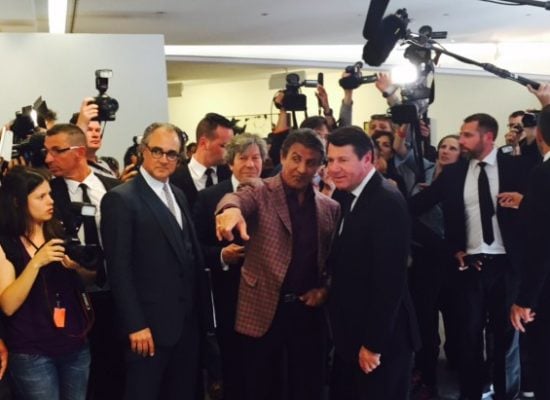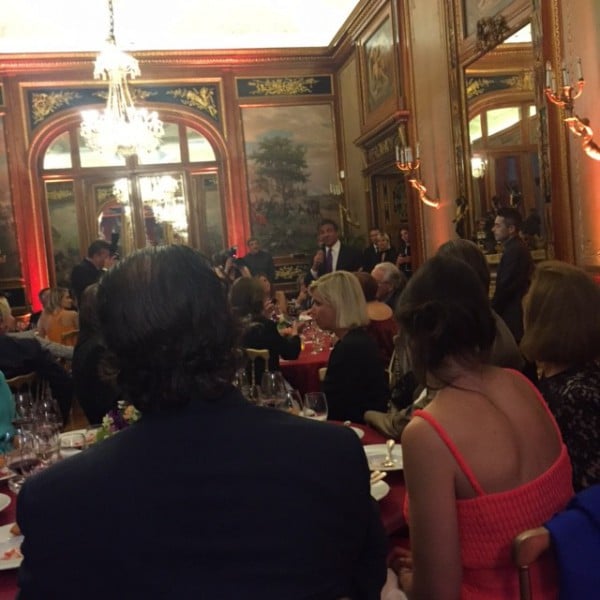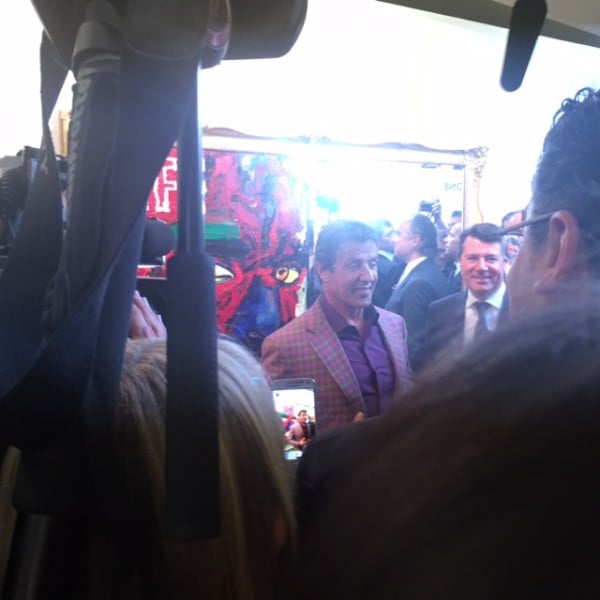Art & Exhibitions
Celebrity Artist Sylvester Stallone Tames Massive Crowd at Glitzy French Riviera Show Opening
In his canvases, Stallone often confronts his own filmic persona head on.
In his canvases, Stallone often confronts his own filmic persona head on.
Anthony Haden-Guest


At the Cannes Film Festival a few miles down the coast, selfies had been banned and Matthew Mcconaughey had been hissed at at a screening. But here in Nice, just before the opening of the Sylvester Stallone retrospective at the Museum of Modern and Contemporary Art, the mood was up, up, up.
A press conference kicked it off. Stallone was seated between Mathias Rastorfer from the Gmurzynska Gallery, Zurich, the first major gallery to show his work (see Mathias Rastorfer On the Arrogant Naiveté of Today’s Art World and the Future of Galleries and Fairs), Christian Estrosi, the mayor of Nice, and Daniel Moquay, director of the Yves Klein Archives, who had curated the show.
At each end of the stage stood two taut men with cropped hair, black suits, black ties, white shirts, and body language that suggested fans should restrain their enthusiasm.
Estrosi opened, welcoming Stallone to the city of Yves Klein, Niki de Saint Phalle, Martial Raysse, Arman, and Bernar Venet. He ended by noting that Robert De Niro had presented the paintings of his father, Robert De Niro Sr., at just this venue (see Robert De Niro Sr. Is Having His Moment in the Art World and Auction Record for Robert De Niro Sr., Painter).
Questions veered from the sensible to the tabloidy, with some clearly engineered to generate coverage, as when Stallone was asked how he felt about the statue of Rocky (the boxer character from the 1976 film that launched his career) being moved from the top to the bottom of the steps at the Philadelphia Museum of Art.
Stallone beamed, and said that was in keeping with the Rocky character’s basic humility. “Rocky belongs at the bottom of the steps,” he said.
Inevitably, some questions focused on Stallone’s movie career, as though this event were not being held in an art museum, but down the road in Cannes.
Stallone dealt with these questions amiably. “But I’m done with the jungle,” he said. “No Eye of the Tiger anymore.”
Another questioner mentioned that Stallone had starred with Anthony Quinn in Avenging Angelo (2002), which turned out to be Quinn’s last movie. Quinn, who also made art, had been a hobbyist. His work would not be in the marketplace if he were not famous. So, as with Adolf Hitler, water-colorist, he is a Celebrity Artist.
“Were you able to take something from Anthony Quinn?” the man asked.
Stallone, unfazed by the question, spoke of Quinn’s bravery as his end approached and said he kept a statuette of Quinn where he worked. The questioner observed that he knew somebody who had a Quinn painting.
“I’ll steal it,” Stallone said, forcefully.

Atmosphere at dinner for Sylvester Stallone.
Photo: Courtesy Anthony Haden-Guest.
So the festivities carried on to the opening of the show, which swiftly became a series of photographic explosions, as the black suits, reinforced by other black suits, formed a cordon around Stallone as he moved through the muscular ballet of flying photographer elbows—“Sly!” “Sly!” “Sly!”—from painting to painting. So heated did the traveling scrum become that one of Stallone’s black suits grew alarmed for the art. “Les tableaux!” he barked. “Les tableaux!” (The pictures, the pictures!) It was a Fellini sequence, but as shot by an action movie director.
When the turbulence had passed, I went back to the work. In Nice, this falls readily into two groups and I had been familiar with the first, indeed had written about it when Gmurzynska showed it at Art Basel in Miami Beach 2009.
In these canvases, Stallone often confronts his own filmic persona head on, using gloved images of a boxer, and, in one piece, a photograph of himself. So he too was unashamedly presenting himself as a Celebrity Artist. But a very singular one.
“I had entered this alternate universe” he told me before the 2009 exhibition, “Where I was now being related to as a character. As Rambo and Rocky, a hero, and my identity was really secondary. And I thought this was kind of interesting.”
The canvases can disconcert in that they lack the protective irony of Pop. But why should we expect irony? Marilyn Monroe would not have painted herself as Warhol did. Jacqueline Kennedy could not have painted Blue Jackie. Nor indeed was all the art about Sylvester Stallone.
“I started doing a series of paintings about other actors that had to wear two faces,” he said at the time. “And I would paint their personas. And I would usually insert a clock in the painting, showing what time in their career it was. So if it was like six o’clock, the picture would be somewhat optimistic. But by eleven or twelve, usually this industry exacts a toll. And it wasn’t until I started to get onto the other side of this world, which is the very rare air of celebrity and stardom, that I began to look at my peers and realized that it wasn’t so much happiness that I saw as disappointment.”

Atmosphere at Sylvester Stallone retrospective opening at the Museum of Modern and Contemporary Art, Nice.
Photo: Courtesy Anthony Haden-Guest.
When we had spoken before his Miami show, Stallone had told me that that was the greatest moment of his life. “Even if it doesn’t go any further,” he had said. “If there’s one sector that doesn’t rate fools, it’s painting. You have a moment, and then you’re gone.”
Well, in 2013, he had a retrospective at the State Russian Museum in St. Petersburg. And now he’s having one in Nice. So the moment continues.
“Yes,” Stallone agreed on Saturday.
Was he still dealing with the phenomenon of celebrity? He shook his head and said he had moved away from that.
And so he has. The pieces from the last couple of years are abstracts, thickly painted, with blacks, white, crimsons. “A frame to me indicates that it’s done,” he had told me in 2009. “Whereas when it’s not framed there’s still room to grow.” These abstractions have frames of Stallone’s own design, kind of like the letter “T,” so they look like they have shoulders. Sometimes the drama in the earlier pieces seems a manifestation of the painter’s will. In these canvases, where touches of figuration are absent or rare, the energy is wholly fomented by the paint.
The celebratory dinner was in the Villa Massena, a living museum of sorts named for Andre Massena, a Nicois boy made good and the most brilliant of the marshals of Napoleon, whose portrait was one of many on the wall (see Napoleon’s Hat Sells for $2.2 Million). The room was all gilt crimson, chandeliers, and bas-reliefs of sexless nymphs carrying urns on their heads. Wine flowed, and there were toasts. Old world, new world.
The following morning, I ran into Moquay of the Yves Klein Archives outside the hotel—an old acquaintance. We chatted.
“I did this against the wishes of everybody, and I am very glad,” he said. “He is a very nice man. And the art is good.”

Photo: Isabelle Bscher.

Photo: Isabelle Bscher.

Photo: Isabelle Bscher.